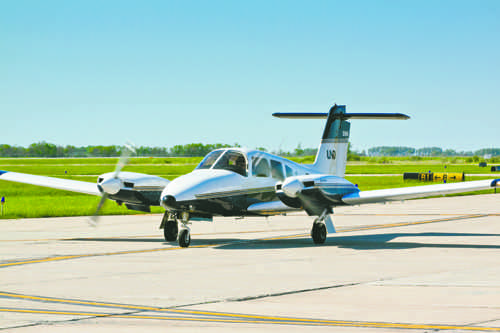Goodbye, hawks

The Dakota Student/Keisuke Yoshi
Piper Seminole
October 11, 2016
“Cost is not number one (when considering aircraft), in fact, cost is way down the list when we look at that.”– Dick Schultz
The University of North Dakota will be changing its primary training fleet over the next few years, the John D. Odegard School of Aerospace Sciences decided this April. Now, the first of the airplanes are coming off the assembly line.
Every eight years, according to Director of Flight Operations Dick Schultz, the university upgrades its fleet due to the rising cost of maintenance and frequent flights of the airplanes.
Piper won this current round of selection, competing against Cessna, Cirrus, Diamond and another company, which was offering to refurbish the school’s current airplanes.
UND ordered 112 aircraft from Piper, which was announced by the company April 5. The order will replace the current Cessna 172S Skyhawk fleet with Piper Archer TX aircraft, as well as update the twin-engined Piper Seminolew.
According to Piper, a new Archer TX airplane cost at least $345,000, but Schultz asserts “cost is not number one (when considering aircraft), in fact, cost is way down the list when we look at that.”
Negotiations for new aircraft are handled by a “Fleet Committee” made up of flight operators, financial advisors, safety advisors and other UND staff.
“It’s more than just the actual purchase of aircraft,” added Elizabeth Bjerke, Chair of the Aviation Department. “Piper has created a number of internships for students, they’re also giving scholarship dollars with each aircraft purchase, so we’re looking at the big picture of what’s going to be the best fit for the program.”
The first eight aircraft will be delivered in Jan. 2017, with students taking Aviation 221 and 415 flying the Archers during the spring semester.
The primary difference for students flying will be the wings: the Cessna airplanes have a “high-wing” design, with their wings mounted above the fuselage, while the Pipers will use a “low-wing” design on the bottom of the airplane.
Jeremy Roesler, Chief Flight Instructor at UND, described some other differences and similarities between the two: both planes are powered by a 180-horsepower Lycoming piston engine (the previous trainer airplane used by the school, the Piper Warrior, had a 150-hp engine); the Archer is also a little faster and more fuel efficient than the Cessnas, and can tolerate higher winds.
According to Roesler, the primary differences for students will be the higher speed of the Archer, and the change of visibility due to the lower wing. Two other key differences Roesler pointed out were that the Archer TX only has one door instead of the two on the Cessnas, and a smaller backseat area than the Skyhawks.
One thing Schultz, Bjerke and Roesler make clear, though, is all of this is done with aviation students in mind.
“We literally evaluate year by year what’s best for the school,” said Roesler, ”and ultimately what’s best for the student.”
While the Cessnas may be phased out, the school’s fleet will not be entirely free of them; two Cessna 150 two-seater airplanes will be kept for aviation competitions.
Connor Johnson is a staff writer for The Dakota Student. He can be reached at cljohnson317@gmail.com

